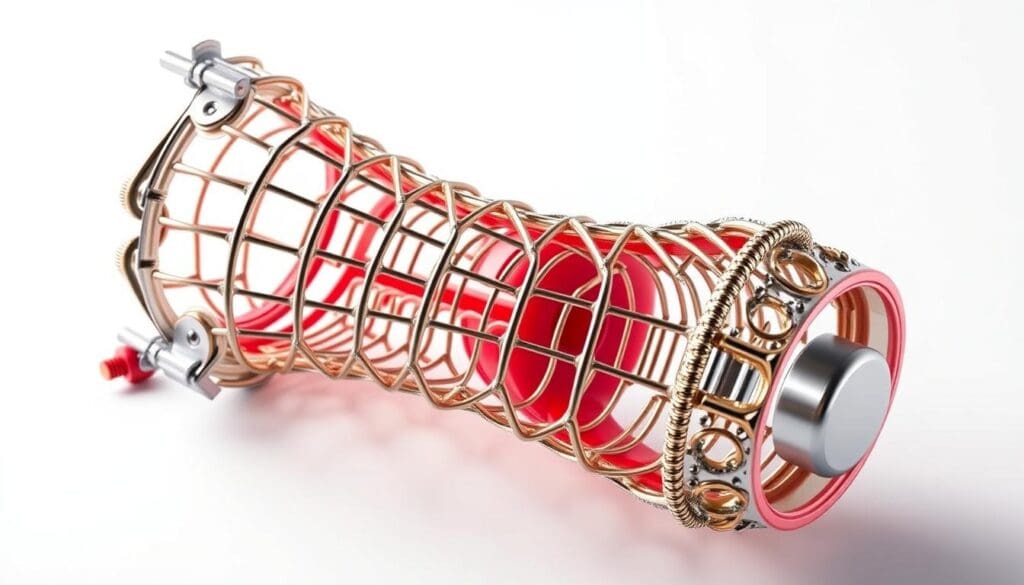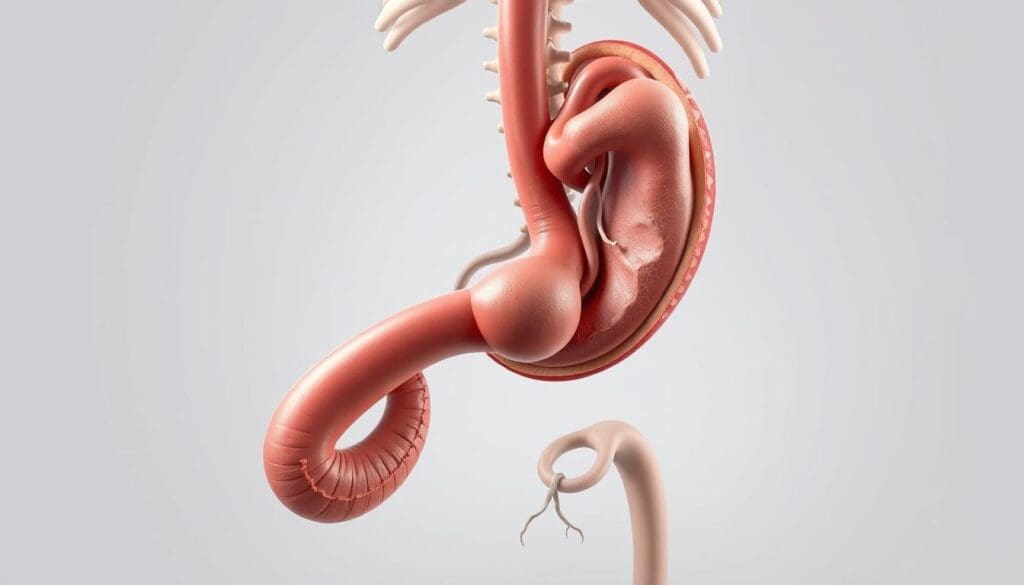Last Updated on November 26, 2025 by Bilal Hasdemir

The treatment of abdominal aortic aneurysms (AAA) has changed a lot with aortic stent grafts. These new devices have made a big difference. They offer a less invasive option compared to old surgery methods.
Aortic stent graft procedures help by strengthening the weak spots in the aorta. This stops the aneurysm from getting bigger and bursting. Thanks to this, more people are choosing this safer, quicker way to fix AAA.
Key Takeaways
- Understanding the role of aortic stent grafts in treating AAA.
- The benefits of minimally invasive EVAR procedures.
- How stent grafts reinforce weakened vessel walls.
- Improved patient outcomes with aortic stent grafts.
- The significance of EVAR in AAA treatment.
Understanding Abdominal Aortic Aneurysms (AAA)

Abdominal aortic aneurysms often don’t show symptoms, making it key to know their causes and risk factors. An AAA happens when the aorta, the main blood vessel, gets bigger or balloons. This can cause serious problems if not caught and treated right.
Causes of Abdominal Aortic Aneurysms
The exact reason for AAA is not always known. But, many things can lead to it. Atherosclerosis, or plaque buildup in arteries, is a big factor. Also, having a family history of aneurysms can increase your risk.
Risk Factors and Prevalence in Adults Over 65
Some things make getting an AAA more likely. Advanced age is a big one, with risk going up after 65. Smoking is also a major risk. And, men are more likely to get AAA than women.
Knowing these risk factors is key for catching AAA early. Studies show that screening men over 65 can lower death rates from AAA. So, it’s important to understand AAA to help patients better.
The Evolution of AAA Treatment Approaches

Managing AAA has changed, moving to newer, less invasive methods. This change comes from better technology and understanding of blood vessels.
Traditional Open Surgical Repair
Before, treating AAA meant open surgical repair. This big surgery replaced the weak part of the aorta with a synthetic graft. It’s effective but invasive, needing a big cut and a long recovery. A study in the Journal of Cardiovascular Medicine shows it was the top choice for many years Transition to Minimally Invasive Techniques
The field of AAA treatment shifted with endovascular aneurysm repair (EVAR). EVAR is a minimally invasive technique that uses a stent graft to bypass the aneurysm. It’s less invasive, leading to shorter hospital stays and faster recovery.
- Reduced risk of complications
- Less post-operative pain
- Shorter recovery period
Current Standard of Care
Now, EVAR is a standard treatment for many with AAA. It involves precise planning and imaging for the stent graft’s placement. Studies show EVAR is preferred for its effectiveness and lower risks compared to open repair.
The evolution of AAA treatment shows the need for ongoing innovation in vascular surgery. As technology improves, we can look forward to better patient outcomes and quality of life.
How Aortic Stent Grafts Function in AAA Management
Aortic stent grafts have changed how we treat abdominal aortic aneurysms (AAA). They offer a less invasive way to treat this condition. These devices keep the aneurysm from growing and bursting.
Structure and Components of Stent Grafts
Aortic stent grafts have a metal stent covered in fabric. The stent keeps the graft open. The fabric lines the aorta, making sure blood flows through the graft, not into the aneurysm.
Key components include:
- The stent framework, typically made from nitinol or stainless steel
- The graft material, usually a biocompatible fabric such as polyester or PTFE
- Attachment mechanisms to secure the graft in place
Reinforcing Weakened Vessel Walls
The main job of an aortic stent graft is to strengthen the aortic wall. It stops the aneurysm from getting bigger or bursting. The graft fits tightly in the aorta, sealing it well to prevent leaks.
The following table summarizes the key features and benefits of aortic stent grafts:
| Feature | Description | Benefit |
| Minimally Invasive | Inserted through small incisions | Reduced recovery time |
| Stent Framework | Made from nitinol or stainless steel | Provides structural support |
| Graft Material | Biocompatible fabric | Prevents blood flow into aneurysm sac |
The EVAR Procedure: Aortic Stent Graft Placement
The Endovascular Aneurysm Repair (EVAR) procedure has changed how we treat Abdominal Aortic Aneurysms (AAA). It’s a less invasive option compared to traditional surgery. This method uses an aortic stent graft to strengthen the aorta’s weak spots.
Pre-Procedure Planning and Imaging Requirements
Before starting EVAR, detailed planning is key. This includes imaging studies to check the aneurysm’s size and shape. High-resolution CT angiography is often used for this purpose.
“Accurate imaging is vital for EVAR success,” say vascular surgeons.
“The complexity of AAA anatomy demands precise imaging to ensure the stent graft is appropriately sized and positioned.”
Step-by-Step Placement Technique
The EVAR procedure has several steps:
- Accessing the femoral arteries under local anesthesia.
- Guiding a catheter through the arterial system to the aneurysm site.
- Deploying the aortic stent graft to block blood flow to the aneurysm.
- Checking the stent graft’s position and ensuring no leaks.
The precise placement of the stent graft is essential for EVAR success. It requires a skilled vascular team.
Post-Procedure Care and Recovery Timeline
After EVAR, patients are watched for a few hours before moving to a regular room. Most can go back to their usual activities in a few weeks. This is much quicker than open surgery recovery.
EVAR is a big step forward in treating AAA. It offers a safer, less invasive option than traditional surgery. As technology gets better, EVAR’s benefits will likely grow.
Clinical Benefits of Endovascular Stent Placement
Endovascular stent placement leads to shorter hospital stays and better quality of life for those with abdominal aortic aneurysms (AAA). This method is a big step forward from traditional surgery. It offers many benefits.
Reduced Hospital Stays and Recovery Time
Endovascular aneurysm repair (EVAR) cuts down on hospital time. Patients heal faster and can get back to their lives sooner. Studies show EVAR leads to shorter stays in the ICU and hospital compared to open surgery.
Patient Outcomes and Quality of Life Improvements
EVAR’s benefits go beyond quicker recovery. It leads to fewer complications and a lower death risk compared to open surgery. The stent for abdominal aortic aneurysm strengthens the weakened wall, reducing the risk of rupture.
Thanks to abdominal aortic graft tech and vascular surgeon skills, patients see better outcomes. They can often get back to their pre-aneurysm activities, improving their quality of life.
Advanced Aortic Stent Graft Technologies
The field of vascular surgery is changing fast with new aortic stent grafts. These devices are better at handling abdominal aortic aneurysms (AAA) than old ones.
Polymer-Sealing Devices
Polymer-sealing devices are a big step forward in stent graft tech. They use a polymer seal to stick better in the aorta. This might lower the chance of leaks and make EVAR safer for patients.
Key Features of Polymer-Sealing Devices:
- Enhanced sealing mechanism
- Potential reduction in endoleak rates
- Improved adaptability to aortic morphology
Branched and Fenestrated Stent Grafts
Branched and fenestrated stent grafts are key for complex aortic aneurysms. They have special parts for blood flow to important branches. This is great for patients with aneurysms near these branches.
| Feature | Branched Stent Grafts | Fenestrated Stent Grafts |
| Design Purpose | Preserve blood flow to major branches | Allow perfusion of branch vessels through fenestrations |
| Clinical Benefit | Enable treatment of complex aneurysms involving major aortic branches | Facilitate EVAR in cases with challenging aortic anatomy |
Solutions for Anatomically Challenging Cases
These new stent grafts are great for tough cases, like short or bent necks. They’re more flexible and fit better, leading to better placement and sealing.
These advanced stent grafts are opening up EVAR to more patients. They bring hope to those with complex aortic aneurysms.
Potential Complications and Management Strategies
Aortic stent grafts have made EVAR procedures better. But, they can face issues like endoleaks and stent migration. These problems can affect how well the treatment works and the patient’s health.
Endoleaks: Types and Treatment Approaches
Endoleaks happen when blood leaks into the aneurysm sac around the stent graft. There are different types, each needing its own way to handle it.
- Type I Endoleak: This happens when the stent graft doesn’t seal well at the ends. Doctors might use more stenting or ballooning to fix it.
- Type II Endoleak: It’s caused by blood flowing back from branches like the lumbar arteries. Many Type II endoleaks get better on their own, but some need embolization.
- Type III Endoleak: This is due to the stent graft failing, like tears or fractures. Doctors usually add more stent grafting to fix it.
- Type IV Endoleak: It’s because the graft material is too porous. Doctors might watch it closely or do more to help.
- Type V Endoleak (Endotension): This is when the aneurysm sac keeps getting pressurized without a leak. Doctors might just keep an eye on it.
| Endoleak Type | Cause | Management |
| Type I | Inadequate seal | Additional stenting or ballooning |
| Type II | Retrograde flow | Observation or embolization |
| Type III | Graft failure | Additional stent grafting |
Stent Migration and Other Long-Term Considerations
Stent migration is a big problem. It happens when the stent graft moves, which can cause endoleaks or other issues. It’s important to watch for this closely.
Other long-term worries include the stent graft getting blocked, wearing out, or a new aneurysm forming. Regular check-ups with imaging are key to catch these problems early.
Management Strategies: Regular check-ups with imaging, quick action for problems, and teaching patients about symptoms to watch for are all important.
Market Growth and Demographics of AAA Treatment
The market for aortic stent grafts is growing fast. This is because more people are getting abdominal aortic aneurysms (AAA) as they age. This growth is due to changes in the population, new medical technologies, and more screening programs.
Projected Market Expansion Through 2035
The AAA treatment market will grow a lot by 2035. This is because more people are getting AAA and new stent graft technologies are coming out. The demand for these grafts will keep going up as the world’s population gets older.
Several factors are driving this growth:
- More AAA cases among older people
- New stent graft technologies, like fenestrated and branched ones
- More people choosing endovascular aneurysm repair (EVAR) procedures
| Year | Projected Market Size (USD Billion) | Growth Rate (%) |
| 2025 | 2.5 | 10 |
| 2030 | 4.2 | 12 |
| 2035 | 6.8 | 15 |
Higher Incidence in Men Over 65
Men over 65 are more likely to get AAA. This makes them a key group for screening and treatment. Research shows that men in this age group are at higher risk, highlighting the need for targeted screening.
Impact of Wider Screening Programs
Wider screening programs are key for early AAA detection and treatment. They help find aneurysms early, allowing for timely intervention. This can prevent serious complications.
The benefits of wider screening include:
- Early detection of AAA, leading to timely treatment
- Lower death rates from AAA ruptures
- More people choosing EVAR, a less invasive treatment
As the demand for aortic stent grafts grows, it’s vital to have screening programs. These programs help identify and treat AAA effectively.
Conclusion: The Future of Aortic Stent Grafts in Vascular Surgery
Aortic stent grafts have changed how we treat Abdominal Aortic Aneurysms (AAA). They have made vascular surgery much better. As technology gets better, we’ll see even more improvements in stent grafts.
This means better care for patients and more options for fixing aneurysms without open surgery. The future of aortic stent grafts is bright. We can look forward to safer and more effective treatments.
As vascular surgery keeps getting better, aortic stent grafts will play a bigger role. More research and new ideas will lead to better care for patients. This will make endovascular stent placement a key part of treating AAA.
FAQ
What is an aortic stent graft?
An aortic stent graft is a medical device. It’s used to treat abdominal aortic aneurysms (AAA). It reinforces the weakened area of the aorta, preventing further dilation and rupture.
How does an aortic stent graft work?
The stent graft is placed inside the aorta through a minimally invasive procedure. It expands to fit snugly against the aortic walls, both above and below the aneurysm. This prevents blood from flowing into the aneurysm sac.
What are the benefits of endovascular aneurysm repair (EVAR) with an aortic stent graft?
EVAR with an aortic stent graft has many benefits. It reduces hospital stays and recovery times. It also improves patient outcomes and quality of life compared to traditional open surgical repair.
What are the possible complications with aortic stent grafts?
Possible complications include endoleaks and stent migration. There are also long-term considerations. These can be managed with ongoing monitoring and, if necessary, additional interventions.
How is an aortic stent graft placed?
The placement involves pre-procedure planning and imaging. It’s done through the femoral arteries. Post-procedure care and recovery follow.
What are the latest advancements in aortic stent graft technology?
Recent advancements include polymer-sealing devices and branched or fenestrated stent grafts. These offer solutions for anatomically challenging cases. They expand the range of patients who can benefit from EVAR.
Who is at risk for developing an abdominal aortic aneurysm (AAA)?
Adults over 65, and men in particular, are at higher risk. Risk factors include atherosclerosis, smoking, and advanced age.
What is the role of screening programs in AAA diagnosis and treatment?
Screening programs are key in early detection and treatment of AAA. They allow for timely intervention. This can reduce the risk of rupture and mortality.
What is the expected recovery time after EVAR with an aortic stent graft?
Patients undergoing EVAR can expect a quick recovery. Most return to normal activities within a few weeks.
Are there different types of aortic stent grafts available?
Yes, there are various types of aortic stent grafts. These include standard, fenestrated, and branched stent grafts. They are designed to accommodate different patient anatomies and needs.
References
- Fernandes, J. F. E. (2020). Abdominal aortic aneurysms – how to treat in today’s practice. European Society of Cardiology Journal of Cardiology Practice. https://www.escardio.org/Journals/E-Journal-of-Cardiology-Practice/Volume-18/abdominal-aortic-aneurysms-how-to-treat-in-today-s-practice






